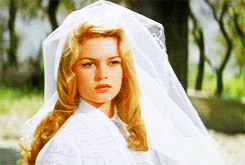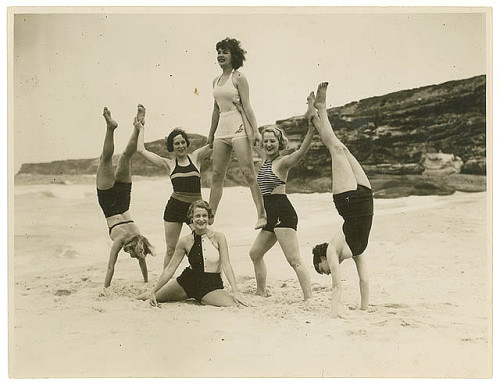Ah je l'aime beacoup <3, elle est parfaite!
viernes, 28 de septiembre de 2012
jueves, 27 de septiembre de 2012
It was an itsy bitsy teeny winnie yellow polka dots bikini!
Si nos ponemos a investigar, el origen del bikini se remonta a tiempos muy antiguos (cosa que me sorprendió). En la Antigua Grecia, las mujeres utilizaban el bikini para hacer deportes, y según pinturas y mosaicos, en Roma también se utilizaba. Este tipo de bañador no es el bikini regular, sino de un tipo de vestuario de dos piezas que dejaba el torso y las piernas al descubierto. Tuvo que correr mucha agua para la creación de la silueta del bikini como lo conocemos hoy, lo cual escribiré a continuación:
If we start to investigate the origin of the bikini it goes back to ancient times (which surprised me) in the Ancient Greece, women used bikini to do sports. Paintings and mosaics show Rome used it too. Such is not the regular bikini swimsuit, but a type of two-piece dress exposing the torso and legs. Much water had to run until the creation of the bikini silhouette as we know it today, which I will explain below:
Básicamente, las causas que influenciaron la evolución del bikini fueron primero, la necesidad de bañarse en publico, en épocas anteriores no era muy popular ir a la playa o al río. Por tanto, no había necesidad de crear una vestimenta para esta ocasión. Luego la comodidad y por supuesto factores culturales y sociales (Liberación Femenina, Moda, 1ra y 2da Guerra Mundial..etc). El primer bañador general, tanto para hombre como para mujer, aparece a finales de la época victoriana, en 1890 aproximadamente, y era una camisa, que cubría todo el brazo, pantalón hasta los tobillos y medias para cubrir los pies. La única diferencia era el material, la tela era un poco mas ligera que de costumbre, pero aun así super incomoda y poco practica. Mas tarde se fueron modificando un poco, retirando las medias para los hombres y acortando las mangas y agregando elementos según lo que estaba de moda.
Basically, the main issue that influenced the evolution of the bikini was the need to bathe in public, in earlier times it was not very popular to go to the beach or river. Therefore, there was no need to create an outfit for the occasion. Then of course the comfort and cultural and social aspects (Women Liberation, Fashion, 1st and 2nd World War). The first swimsuit, both for men and women, appears at the end of the Victorian era, in 1890 or so, and it was a shirt, covering the whole arm, ankle pants and socks to cover feet. The only difference was the material: the fabric was a little lighter than usual, but still super uncomfortable and impractical. Later they were modified slightly by removing the socks for men, shortening the sleeves and adding elements as it was fashionable.
Para la década de los 20, debido a la rebeldía que imperaba, el traje de baño se hizo mas corto (como las faldas y los vestidos) pero se cubría el tobillo y los pies porque no estaba permitido mostrar toda la pierna.
For the 20s, due to the prevailing rebellion, the swimsuit was shorter (like skirts and dresses) but covering the ankle and feet because it was not allowed to show that much leg.
En 1930 nace el traje de baño de dos piezas, ya muy cerca a lo que se convertiría el bikini original. La parte superior era con escote redondo, tipo camiseta y pantalones cortos hasta los muslos. Sin embargo, aunque mostraba mas piel, como estaba hecho de lana era muy pesado cuando se mojaba. Este modelo fue popular durante toda la década y hasta la siguiente.
In 1930 the two piece swimsuit is born, very close to what would become the original bikini. The top was a rounded neckline, and the bottom were shorts. But while showing more skin, since it was made of wool it was very heavy when it got wet. This model was popular throughout the decade up until the next one.
Este es un poco revelador/This one is a little revealing.
Ahora en los años 40, específicamente en 1946, el modisto Jacques Heim y Louis Reard colaboran e inventan el bikini de dos piezas, dejando al descubierto el torso y las piernas. Por supuesto, no tuvo gran aceptación al momento de su nacimiento, era insólito que la mujer mostrara tanta piel en publico, ya que todavía existian muchas limitaciones y prejuicios. El traje de baño de una sola pieza o de dos piezas (pero sin mostrar el ombligo)Ç era mas aceptado, y era la opción por excelencia. Pero la popularidad del bikini aumento a través de los años y mas luego de que se infiltrara su uso en el cine (con Brigitte Bardot, Esther Williams, Ursula Andress) y en la moda. Con la evolución de la moda y el surgimiento de nuevos tejidos, el bikini se vuelve cada vez mas codiciado. En los 50s se utilizan distintos patrones: puntos, animal print, rayas, strapless, con tirantes ajustables, y eran hechos mayormente de nylon. Rudi Gernreich dio mucho de que hablar en los 60s con su monokini, consistía en un traje de baño de una pieza que dejaba el busto al descubierto.
Now in the 40s, specifically in 1946, the couturier Jacques Heim and Louis Reard collaborate and invent the two-piece bikini, exposing the torso and legs. Of course, it was not widely accepted at the time of its birth, it was unacceptable for the woman to show much skin in public because there were still many limitations and prejudices. The one-piece or two-piece swimsuit without showing the navel was more accepted, and was the ultimate choice. But its popularity rised through the years and more after the use of it in films (with Brigitte Bardot, Esther Williams, Ursula Andress) and fashion. With the evolution of fashion and the rise of new fabrics, the bikini becomes increasingly coveted. In the 50s they used different patterns: dots, animal print, stripes, strapless, adjustable straps, and were made mainly of nylon. Rudi Gernreich gave a lot to talk about in the 60s with his monokini, it was a one piece swimsuit that left the breasts exposed.
Las versiones mas ''aceptables'' del bikini
Suscribirse a:
Comentarios (Atom)















